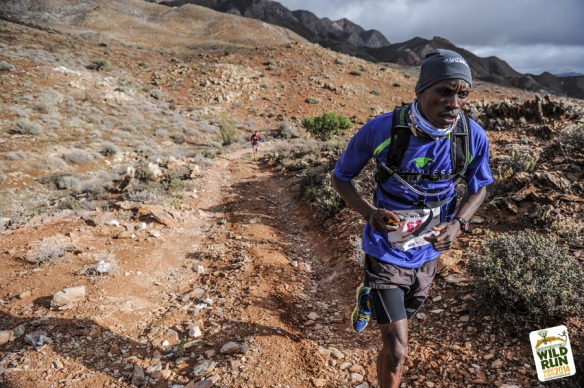It’s game on at the Richtersveld Wildrun™
At the sharp end of this year’s 150km, 4 day Richtersveld Wildrun™ race will be three of Southern Africa’s best trail runners, an American ultra-running legend and a double Olympian gold medallist.
Bernard Rukadza and Katya Soggot will both return to defend their titles and will come up against the likes of South African long distance trail running champion, Thabang Madiba, American ultra-running legend, Nikki Kimball and global adventure extraordinaire, James Cracknell.
The friendly Cape-based Zimbabwean and current Richtersveld Wildrun™ record holder, Rukadza, comes off his second straight victory at the ProNutro AfricanX with teammate, AJ Calitz and will be confident that he can defend his Richtersveld Wildrun™ title. He put in a dominant performance at the inaugural event in 2014, winning three of the four stages and thus goes into this year’s event with a distinct advantage over Madiba. “I know the route from running it last year and I definitely want to win again. I always want to push and improve my time and am looking forward to racing Thabang. He’s very good and it will be fantastic,” he said.

Defending champion, Bernard Rukadza will return to the Richtersveld Wildrun™ from 2-5 June 2015. Image by Kelvin Trautman
Gauteng-based Madiba, on the other hand, will be giving his all and plans to push the limits as he gains more experience in stage racing. He has set his sights firmly on improving his second place at the ProNutro AfricanX, but is philosophical on his approach to the Wildrun™. “Stage racing is one of the races that helps to find your strength in running. You learn to push while in pain and learn techniques to apply to survive all stages. It is only a matter of surviving and reaching the finish line. I’ve never done 150km in four days before and I’m super excited to give it a try. Life becomes interesting when you try new things and get out of your comfort zone. A win will be a big bonus for me but I’m looking forward to give all my best,” he said.

SA long distance trail champion, Thabang Madiba at the Outeniqua Traverse. He will be taking on Bernard Rukadza at the Richtersveld Wildrun™. Image by Kelvin Trautman
“What more can be said other than this is going to be one hell of a race! Bernard has been on fire in the Cape recently, winning everything from marathons to short Spur Trail Series™ events, but Madiba comes with the South African long distance trail champion label and arguably more endurance experience. I can’t wait to see these two trail heavy weights going head to head, solo, and in the magical Richtersveld desert,” said Owen Middleton, MD of Wildrunner – the events company behind the Wildrun™.
Also in the hunt, and sure to be nipping at the heels of Rukadza and Madiba, is second time Richtersveld Wildrun™ challenger, Filippo Faralla as well as British adventurer, James Cracknell.
Soggot vs Kimball

Katya Soggot will be defending her title at the Richtersveld Wildrun™ and facing competition such as Nikki Kimball and Karoline Hanks. Image by Dylan Haskin
In the ladies field, Katya Soggot will be representing South Africa off the back of victories at the Spur Silvermine Mountain XL, Spur Cape Summer Trail Series™, Three Peaks Challenge, Matroosberg Challenge and fourth place at the Otter African Trail Race, to name but a few. Soggot’s continuous achievements will come in handy as she is up against three-time Western States 100 champion, previous Ultra Trail du Mont Blanc champ and current Marathon des Sables champion, Nikki Kimball.
Other top lady runners who are worth keeping an eye on, include the female winner of the 2014 Rhodes Ultra Trail Run and uber-experienced ultra-trail runner Karoline Hanks; third placed female at the Wildcoast Wildrun™ 2014 Harriet Cullinan; and second placed female at the 100km Cederberg Traverse, Georgina Ayre.
“Last year, the ladies race was very amicable, with Katya and Tracy Zunckel running together for a large portion of the time. This year will be so exciting to watch, with at least five really strong contenders for the title. Katya will be looking to defend her title, with the advantage of knowing the route and Nikki is certainly a tough challenger,” says Tamaryn Middleton, general manager of Wildrunner. “Karoline Hanks is also extremely strong and comfortable with self-navigation so is definitely one to watch.”
Soggot has said she has amazing memories from the Richtersveld Wildrun™ in 2014 and is ecstatic to go back again. “The magnitude of untouched wilderness, the comfort and welcome at every rest camp, and the elves who made it so. My feet touched where angels fear to tread. I never dreamt I would have the privilege to relive such an experience and I am overwhelmed with gratitude to Boundless Southern Africa and Wildrunner for the opportunity,” she said.
Since its inception in 2014, the Richtersveld Wildrun™ has had amazing support from Boundless Southern Africa and marketing manager, Roland Vorwerk was equally excited about the quality of racing anticipated. “The Richtersveld Wildrun™ route includes many of the Park’s most spectacular features, and includes trails that very few people get to traverse. We are looking forward to these runners experiencing the unique natural and cultural landscape of the /Ai/Ais-Richtersveld Transfrontier Park and meeting the communities associated with this innovative event.”
Do you fancy joining these incredible athletes in South Africa?
Limited places are available through the UK agent. Please use the contact.
Your message has been sent






